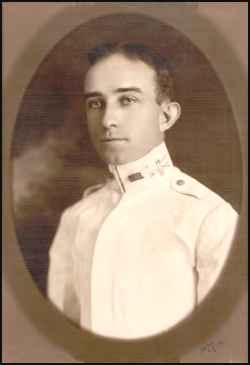
1887-1976 |
 |
Collection of Stephen Heard, 12-4-06 |
|
|
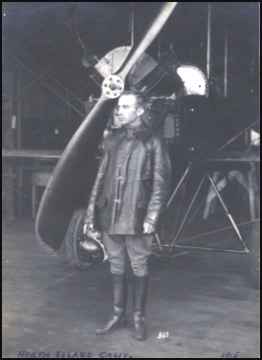 |
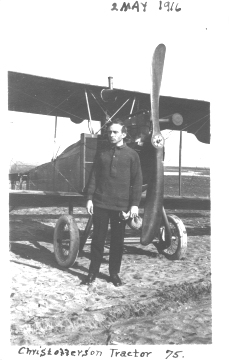 |
North Island, California Collection of Stephen Heard, 12-4-06 |
Christofferson Tractor 75 - May 1916 Collection of Stephen Heard, 12-4-06 |
JACK WHITEHEAD HEARD Class of 1910 Died: Brooke Army Hospital 25 October 1976 Interred: Fort Sam Houston National Cemetery of the morning Even there shall Thy hand lead me" This Biblical excerpt was the watchword of a pioneer aviator whose most exciting and exhilarating experiences in a 41 year Army career came during the 1916 - 1919 era when he was one of America's first military pilots. Throughout his life he treasured his membership in "The Early Birds", a select group which must have soloed not later than 1916. Maj. Gen. Jack W. Heard was born to the service - and especially to the Cavalry. His father was of USMA Class of 1883 (awarded the Medal of Honor during the Spanish-American War) and his grand father fought with Forrest's Mississippi Cavalry. Jack's first Army post was actually old Fort Davis in west Texas to which he traveled by stagecoach with his mother in 1888 - heavily escorted by a detachment of the 3rd Cavalry - to join his father. After a boyhood of travelling about in the Army, he was graduated from West Point in 1910 and received his choice of assignments to the 7th Cavalry, accompanying it to the Philippines a year later. It was here, in 1912, that he became intrigued with one of the two airplanes then owned by the Army and, with neither training nor authorization, took it on a solo flight over Manila Bay. Repeated applications for detail to the Aviation Section of the Signal Corps went unheeded until he was finally ordered to the Signal Corps Aviation School in August 1915. Meanwhile, 1914 had been spent with the 14th Cavalry on the Texas border where, as commander of the Eagle Pass Detachment, he met Ella Agnes McCarthy who was, in 1917, to become his wife of 59 years. Disqualified medically from the Army flying school, he sought a civilian one and later related that "It was the greatest thrill of my life when I graduated by dong a series of figure 8's around two pylons and landed with a dead engine within a 200 foot circle". He received Aviator Pilot Certificate #485. 1916 - 1918 saw Jack rise meteorically from 2nd lieutenant, Cavalry to lieutenant colonel, Air Corps. During this time, he served as first commander of flying at Kelly Field, commander of Scott Field, Illinois and later of Payne Field, Mississippi. In 1919 he organized and led the Flying Circus - a group of stunt pilots who were the forerunners of today's Thunderbirds. Then, the war over, he returned to the Cavalry - and also to the Regular Army grade of Captain! There followed assignments as head of motorization tests for the Cavalry, the Organized Reserves, the C & G S at Leavenworth, the Cavalry School and Board at Fort Riley and squadron commander in the 4th Cavalry at Ft. Meade (So. Dak.). Then came the Army War College, Navy War College, Industrial College and, after a tour with the Chief of Cavalry's office, to the senior course at the Navy War College. He was always proud of the large number of military schools he had attended - even including a Cooks and Bakers School! In 1937 he abandoned the horse Cavalry for the new mechanization and reported for duty with the 1st Cavalry (Mech.) at Fort Knox. The next six years were, except for his aviation days, the most memorable of his career, comprising assignments to the 7th Cavalry Brigade (Mech.), the Mechanized Cavalry Board, commander of the 13th Cavalry (Mech.), commander of the Armored Force Training Center and culminating in command of the 5th Armored Division (1941 - 1943) which he took to California for desert training. Even after his retirement in 1946, he spent thirty full and active years. Jack was interested in everything from philately and numismatics to astronomy, rose culture, history and finance. He wrote and had published in 1969 his autobiography - copies of which were requested by numerous libraries, museums and scholars. Among his many associations were: the Newcomen Society, Military Order of the World War, 32nd degree Mason, Early Birds, Association for the Blind and the Witte Museum of San Antonio. Each summer of retirement he commuted with Ella from their San Antonio winter home to their Silver Lake, N.H. summer place - being active in the community and with many friends in both locations. The latter especially gave him an opportunity to spend vacation time with his children and thirteen grandchildren and their families - all of whom considered his home theirs. One of his greatest thrills came in 1974 when he took the review of the Corps as the Oldest Graduate present and watched 4th generation USMA Stephen (Class of '78) march by. Jack left behind his beloved wife, Ella, of San Antonio, sons Col. John (Ret) (USMA '42), Ralph and Lt. Col. Richard (Ret), daughter, Elizabeth (wife of Gen. John R. Deane, Jr. USMA '42), brother, Gen. Townsend Heard and his saddened grand and great-grand children. He was blessed with a long, happy, interesting and successful life, which he enjoyed and of which he took the fullest advantage. He often said that "God has had me by the hand since birth". What more could anyone expect of life? |
|
|
Collection of Jack Cassin, 6-7-06 |
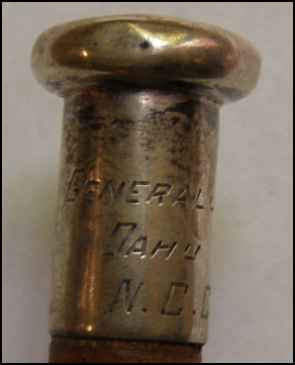 |
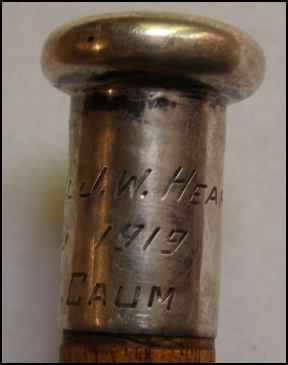 |
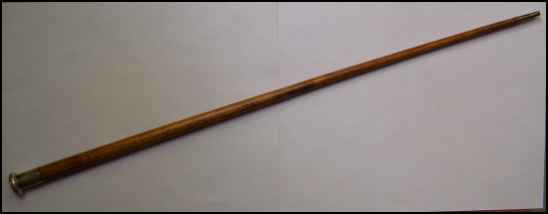 |
The engraved knob and tip are sterling and the length is 21.75 inches |
|
If you have any more information on this Early Bird, please contact me. E-mail to Ralph Cooper Back 

|